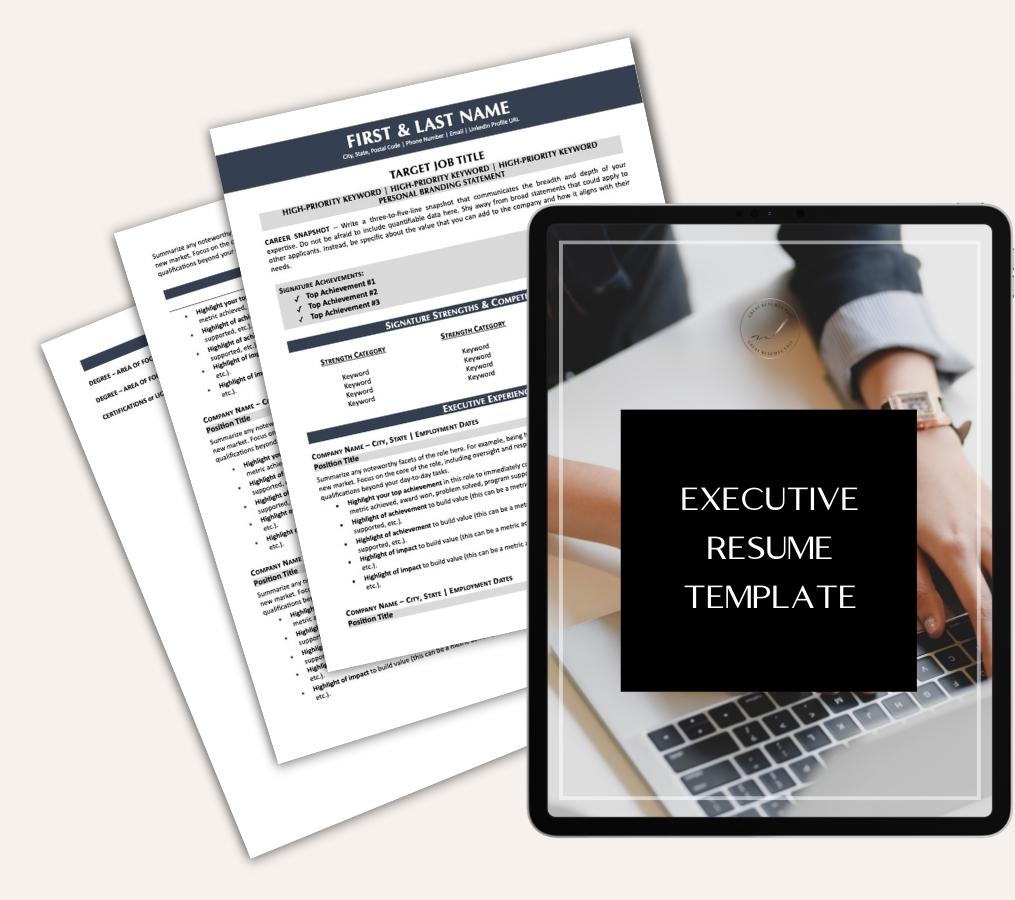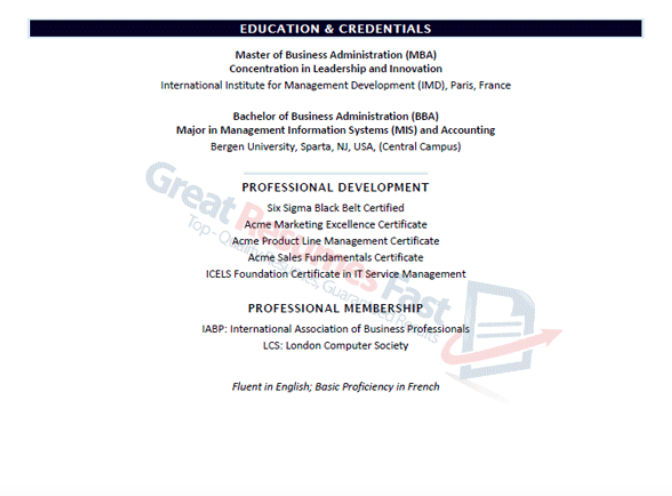What are Some Good Sample Sections for an Executive Resume?
Tips for Writing an Executive Resume: Sections to Include
The final version of your resume should absolutely be broken up into clear sections, delineating topics and making it easier for a hiring manager or recruiter to read. However, determining which sections you want to include before you sit down to write can greatly help you in the process of writing your executive resume. While there is no exact recipe for sections to include, there are some that you may not have considered using that can help strengthen your resume. So what are some good sample sections for an executive resume? Below, I delve into seven of them.
The sample sections I discuss below don’t all have to be included (though I’ll point out the ones that absolutely should be!) but can help get you started as you outline your resume and begin working with formatting to see what best presents your information in an attention-getting manner. To see examples of these sections (and others) in action, head over to our resume samples page to explore resume samples from different industries and positions.
Personal Branding Statement
Let’s start at the top. Well, sort of at the top—your name and contact information should be at the absolute top of the resume. Directly below that, though, you should include a personal branding statement about what sets you apart as an executive. Notice I don’t call this section a career objective—in this day and age your resume should NOT have a career objective. Instead, a personal branding statement that establishes your professional bona fides and potential for contributions to the prospective employer while conveying a bit of your personality or professional brand to the hiring manager should be the first thing they read at the top of your resume. How is this different from a career objective? A career objective tells them what you want. A personal branding statement is a summary that tells them who you are and why hiring you will benefit them. It’s focused on the employer’s needs—not what you want. Remember, your resume is a marketing document.
Amid a sea of resumes with extensive work history, a potential employer will be glad to see a glimpse of fresh information with a personal branding statement that speaks to them. When you’re applying for an executive position, your resume is up against plenty of others who have lengthy professional experience—use a personal branding statement at the top of your resume to get attention and stand out from the pack right away. Again, remember that the point of your resume is marketing yourself.
Work Experience
Obvious, right? But what might not be obvious is that you don’t have to call it work experience. An effective executive resume isn’t a comprehensive chronological list of job titles, years of experience, and duties/responsibilities. Instead, it should touch on the most relevant and impressive highlights of your career.
Your master resume should be comprehensive, but as you tailor your resume for different executive positions the experience and achievements you highlight should differ. Some may focus more directly on what a job description asks for, and for others you may be left on your own to decide what to include based on your knowledge of the company and the position you’re applying to. First and foremost, include impressive and relevant experience.
Even if you are creating a chronological resume—and not a hybrid of a functional resume and a chronological resume—you don’t need to include every last detail about your employment. A resume should go back 15 years at most, and the descriptions of your accomplishments and experience within the different jobs you’ve held don’t need to be comprehensive—again, impressive and relevant are two words to keep in mind here.
As the information in the section differs, you can choose from different headings for the section as well. For example, consider using “Career Highlights” in place of simply “Work Experience” or “Professional Experience.” To make your resume even a little more keyword-friendly, try using “Executive Experience” if that fits with the information within the section.
Education
By the time you’ve reached the executive level of your career, do you still need to include your education on a resume? I recommend that you do—especially if you have an advanced degree. For the most part, I advise putting the education section at the end of your resume. That’s where prospective employers and executive recruiters tend to look for it.
While education is important, accomplishments and experience are more likely to keep a recruiter reading than seeing that you earned a BA in 1992. If the job description specifically asks for an MBA or an advanced degree in marketing, or whatever sector the job is in, you can put those credentials next to your name at the top or include it in your summary so that a hiring manager can immediately see that you fit the most basic qualifications for the job before they go on to being impressed by the rest of the information in your executive resume. This isn’t a hard and fast rule for everyone but something to consider if the degree is an essential part of the requirements for the position.
Certifications, Professional Development, & Affiliations
In addition to listing your degree(s), you should also include relevant certifications or professional development experiences on your executive resume. Doing so demonstrates that no matter how far you have come in your career you are always willing to learn and to take steps to improve yourself so that you can do better work for your employer.
Similarly, any affiliations you have with professional organizations—or even relevant community organizations—show your dedication to your profession and commitment to ongoing learning and networking that can benefit a company.
This section doesn’t necessarily have to be separate from your education section, as seen in the example below:
Testimonials/Quotes
But what about the “References Available Upon Request” line? Or, listing reference contacts or including reference letters if requested? Of course, do whatever is required based on the job posting—but don’t be shy about including actual testimonial quotes about your skills and abilities on the resume itself.
A sidebar with two to three quotes from former supervisors or impressive colleagues that solidly speak to your abilities is an easy way to get important and effective information quickly and directly in front of the prospective employer or recruiter who is reading your resume.
You can also present testimonials and quotes visually by using bordered text boxes or text boxes with a background color that are placed in their own section within your resume, or alongside relevant information in your experience or strengths section.
Achievements/Accomplishments
Between your branding statement and your professional experience / career highlights section, you should have addressed most, if not all, of the relevant achievements of your career. However, if there are particularly impressive accomplishments that you want to call attention to you can include a separate section in which you focus directly on these. When you make it clear to a potential employer that you have tangible achievements to point to that have benefited your past employer, they will be able to see how you can bring value to their business.
Expertise/Skills/Strengths
Like your achievements and accomplishments, some of these should be built directly into your branding statement and your work experience / career highlights section. However, as with the education section, if the job description calls for specific skills or strengths, you need to show early on and clearly in your resume that you have those qualifications. In this case, a separate section for your expertise, skills, or strengths is a good idea for making sure that your executive resume is effective.
Including a section for your expertise, skills, and strengths, or any combination thereof is also an opportunity to make sure that the employer sees your value. If your expertise is especially unique and relevant to the position for which you are applying, highlight it with its own section, and put it near the top of your resume—perhaps even combined with or right below your branding statement.
An important note: any skills section of your resume needs to focus on hard skills and technical skills, not soft skills like “effective communicator” or “detail-oriented.” These have no place on an executive resume.
How to Incorporate These Sample Sections and Other Sections
As I mentioned earlier, the resume samples section of our website can provide you with inspiration on arranging sections effectively within your executive resume.
In looking through a sample executive resume or a few of them, you might also notice infographics and color to help offset the sections, improve readability, and emphasize important information. Including visuals is one of my top recommendations for creating a modern, effective executive resume. You don’t have to go overboard, but even a visual or two can go a long way in differentiating your resume—and you—from the pile of resumes sitting on a hiring manager’s desk.
Not all of your resumes will include the same sections and the same information, nor should they. Play around with the sections and the formatting to create resumes that fit the job and the industry you are applying to. If this sounds time-consuming, that’s because it is. Starting with a master resume can help, though, and once you land that interview and get the executive position you want, the time commitment will be worth it.
But how do I fit all this information on my resume? You know you don’t have to fit every bit of information about your employment history on your resume, but you still probably have a lot that is relevant that you need to include. Don’t fear—a limited one-page resume is not necessary. A two-page resume or even a three-page resume format is perfectly fine (and even expected by recruiters and employers) for an executive candidate. That said, keep your cover letter to one page, though.
If writing a resume just isn’t something you want to take on, even though you’re ready to advance your career, consider using a professional resume writing service like Great Resumes Fast to have a talented resume writer do the work for you. Our team of certified executive resume writers has industry and human resources experience, and our writers work every day to create personalized, modern, and professional resumes to help executives more effectively move through the hiring process and advance their careers.
Are you tired of your resume being rejected by applicant tracking systems? I know how frustrating it is to submit your resume and receive no response. I hate seeing qualified people never breakthrough the screening process. It shouldn’t be that way. That’s why I created this guide and I encourage you to download the FREE PDF so you can start seeing better resume response rates!
Share this post:

About the author
Jessica Hernandez, President, CEO & Founder of Great Resumes Fast
Hi, I’m Jessica. I started this company back in 2008 after more than a decade directing hiring practices at Fortune 500 companies.
What started as a side hustle (before that was even a word!) helping friends of friends with their resumes has now grown into a company that serves hundreds of happy clients a year. But the personal touch? I’ve kept that.
You might have seen me featured as a resume expert in publications like Forbes, Fast Company, and Fortune. And in 2020, I was honored to be named as a LinkedIn Top Voice of the year!
I’m so glad you’re here, and I can’t wait to help you find your next perfect-fit position!
3 Comments
Leave a Comment
Improve Your Resume: Download Your Free Executive Resume Template Today
Are you struggling to create an executive resume that will impress employers? Download this free executive resume template and receive a series of 10 emails with expert guidance on how to write resume content that resonates with employers so you get more interviews.
It's everything you need to stand out, make an impression, and accelerate your job search.










[…] post What are Some Good Sample Sections for an Executive Resume? appeared first on Blog | Great Resumes […]
[…] post What are Some Good Sample Sections for an Executive Resume? appeared first on Blog | Great Resumes […]
In the executive level, Resume plays a vital role in the interview. A perfect CV or resume leaves a good impression on the interviewer & increased the chance of priority in the Interview process.